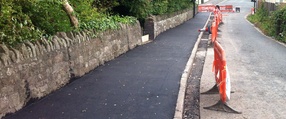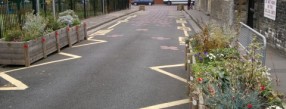Improve Footway Environment
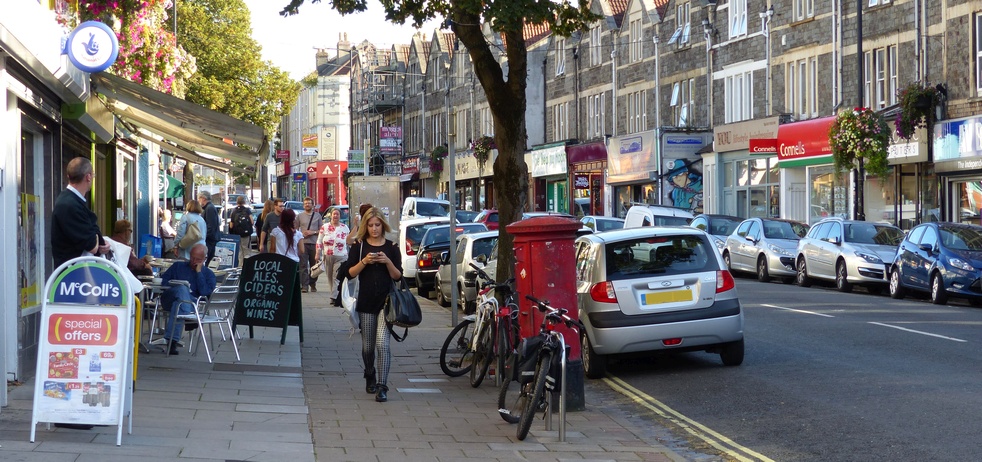
Improving the footway environment could involve a range of measures. Basic measures ensuring the foot way is:
- well lit at night (preferably with white, and not yellow lights)
- is maintained well, with an even surface, kerbs in good condition, and all utility covers level with the footway
- cleaned to a good standard, with litter removed regularly, and any fallen leaves collected
There are also measures which aim to improve the look and feel of the footway environment. These aim to create an interesting environment which is pleasing to look at. Some examples include:
- block paving on the footway, instead of black tarmac
- providing benches (which should not obstruct the footway)
- planting trees
- street artwork, either on the footway itself or on walls/buildings nearby
- encouraging cafés to open next to the footway
- encouraging musicians to play
- and more expensive measures, such as fountains
Some of the measures above have further benefits. For example, trees provide shade in the summer, and benches can provide a valuable place to rest, especially for older people.
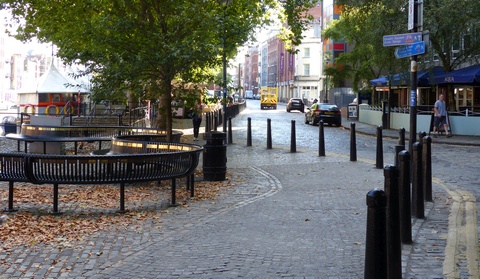
Disadvantages
- Compared to other choices, the benefit of improving footways may be less clear
- Care must be taken to choose measures which cannot be easily vandalised. Planting more mature trees, and choosing particular bench designs will reduce the chances of vandalism.
Restrictions
- In some locations, there will not be enough space for footway improvement measures, as they will obstruct the path for pedestrians. It is important to avoid cluttering the footway where there is limited space.
There's also some general restrictions to note for all schemes
Advantages
- Footways will become easier to use with basic measures (such as better lighting, and regular maintenance)
- Improving the look and feel of the footway keeps the environment pleasant and more enjoyable for pedestrians
- In Bristol, there are some grants available for the improvement of footways and walkways
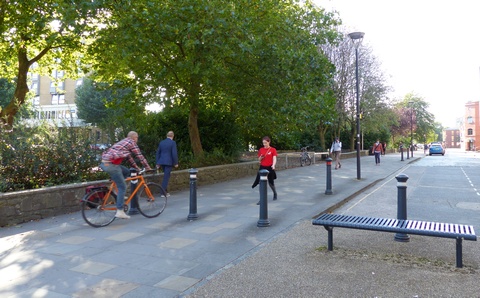
Effectiveness
Improving the footway with all the measures suggested on this page will greatly encourage walking, and encourage people to walk for longer distances. However, any combination of these measures, (or just one of them) will improve the footway environment and encourage people to walk.
It is especially useful for pedestrians if the footway is up to a basic standard first before other measures are considered.
Basic measures to ensure the footway is well lit, maintained to a good standard, and is cleaned regularly should take place first. Measures to create an interesting and pleasing environment, with block paving, trees and artwork etc. should place later, but will also have a very positive impact on the footway, and will greatly encourage more people to walk.
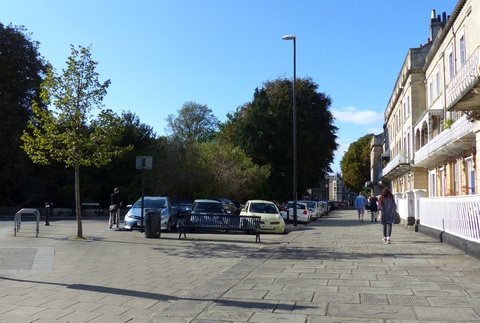
Advanced information
The statement that improving the footway environment greatly encourages walking is primarily based on two high quality evidence pieces.
Pooley et al. (2012) employed a good quality research design which included both quantitative and qualitative data from four English towns. The study comprised of data collected from a large number of respondents using a survey, and more in-depth interviews with a smaller number of people. This research is considered to be of high quality. With regard to walking, the authors identify good lighting, a good standard of maintenance and the removal of leaves and ice as elements required to create welcoming pedestrian routes, which in turn provides the greatest possibility of increasing levels of walking. These elements were referred to as ‘basic measures’ in the section above. It is important to note that the authors also identified a wide footway (which is clear of any obstructions), as an important element for increasing footfall, along with the measures above.
A second evidence piece by Pucher & Buehler (2010) draws upon many sources of evidence to identify particular measures which improve the look and feel of the pedestrian environment. Similar to the previous authors, wide, well maintained, and well lit footways are identified as important measures for encouraging walking, but other measures are also identified, including “include attractive paving, comfortable benches, shade trees, outdoor cafés, public art, fountains, and street musicians”. These findings are based on work from multiple authors, which increases the robustness of this information. Other factors were also identified as helping to encouraging walking, but these were omitted in the piece above as they require strategic level intervention – these were based around landscaping, shop frontages, ground floor entrances to buildings, and architectural design of plazas.
One final research piece is consistent with the studies above, but it is considered poor quality, because the study is relatively old, and it only compared two study locations. Lövemark (1972) outlines research conducted in Sweden, which compared two urban areas comprising very similar characteristics, with the exception of footway width and footway environment interest. Using 700 qualitative interviews, the interesting environment with wider footways was found to have 30% longer pedestrian journeys.
References
Lövemark, O. (1972) New Approaches to Pedestrian Problems Accident analysis and prevention 37 pp. 742 - 754.
Pooley, C., Tight, M., Jones, T., Horton, D., Scheldeman, A., Jopson, A., Mullen, C., Chisholm, A., Strano, E., Constantine, S. (2011) Understanding Walking and Cycling, Summary of Key Findings and Recommendations. Research funded by the Engineering and Physical Sciences Research Council.
Pucher, J. & Buehler, R. (2010) Walking and Cycling for Healthy Cities Built Environment 36 (4) pp. 391 - 414.

